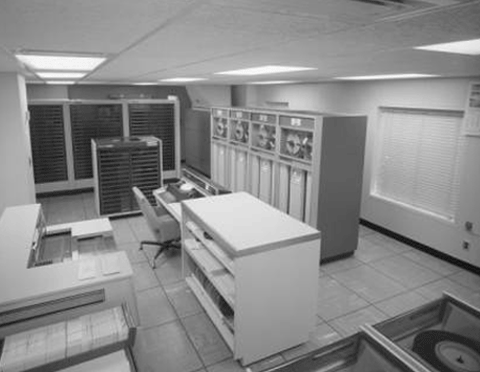mainframe
People Working in Computer Room
As part of my dissertation I’m working with the Southern California Edison Photographs and Negatives collection at the Huntington Library. The photographic collection is now available online at the Huntington Digital Library. A few years ago, when I first came across this collection, it was only available in-person on a single computer.
I stitched the two photos below into an animated gif, showing the transition within computerized space. The images are from “People working in computer room with 1” tape drives" in the SCE collection at the Huntington. These before and after photos taken in 1966 at SCE appear to show how people would fit alongside and interact with the mainframe computer.

Photographs such as these often show many people in the room, mostly trying to look busy, with a few of them staring at equipment or pretending to use the machine. These staged photographs for internal use are similar to those used for marketing. In both cases the images are designed to show how people and computers would work together.
The mainframe in these photographs is a Control Data Corporation mainframe, and it appears to be a CDC 3200 system.
The Computer History Museum in Silicon Valley has a brochure for the CDC 3200 mainframe (PDF) available online as well.
(Revised and republished March 29th, 2025)
Project poster and talk last October

Last October I gave a “brown bag” talk (Wayback Machine link) over lunch in the History Department Library at the University of California, Riverside. I spoke for about 40 minutes and gave a wide overview of my project, using images and video clips to help illustrate my research. It was a great turnout of both professors and graduate students, and I received some terrific feedback that I was able to use for future talks.

At the top is the poster I created for the talk at UCR, and the images come from a variety of primary source materials. The inspiration for the color scheme comes the brochure cover just above, which is featured in the online exhibit, “Selling the Computer Revolution,” at the Computer History Museum in Silicon Valley.
The brochure is for an IBM 705 EDPM (Electronic Data Processing Machine), a mainframe computer produced in the mid 1950s. Mainframes like the IBM 705 were powerful workhorses in the business world during the postwar era, handling payroll for thousands of employees. The brochure’s cover features a computer processing unit at the center, with punched cards and magnetic tape for data storage.
(Revised and republished April 6th, 2025)
Keeping TaB with diet soda
TaB soda was named by an IBM mainframe (Wayback Machine link) – now it makes sense. The name was supposed to relate to keeping “tabs” on your weight (Wayback Machine link), rather than being an acronym for “totally artificial beverage.”
To obtain a list of potential names, William Mannen, chief programmer for data processing, programmed the company’s IBM 1401 (Wayback Machine link) mainframe computer to print all possible four-letter word combinations containing a vowel or vowel-sounding letter. The results took a day to print and contained more than 300,000 possible combinations. This list was narrowed down to 600 possibilities, which were then given to the legal department to check against existing trademarks. After legal narrowed the list again, TaB was chosen from among the final two dozen contenders. Why? Because it was distinctive and easy to remember, and it projected the desired image.

(via @melissaterras on Twitter)
(Revised and republished April 21st, 2025)